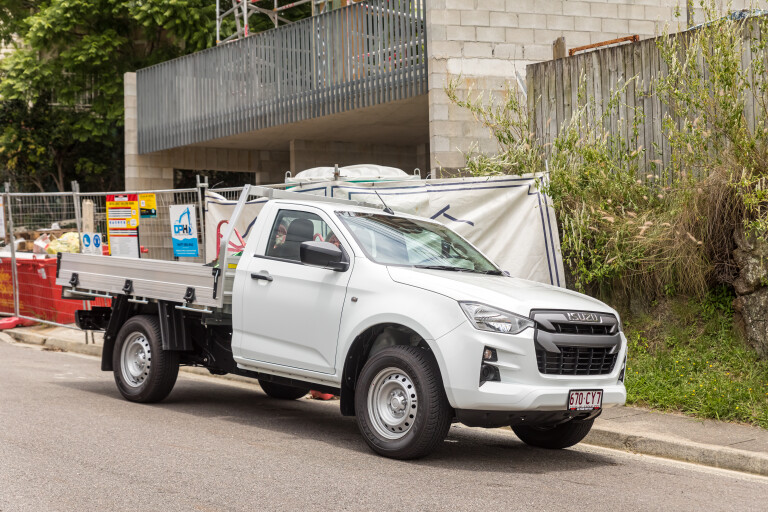
Score breakdown
Things we like
- Increased payload over 3.0-litre variant
- Wireless CarPlay (in a work ute, no less!)
- Impressive fuel economy, even when driven with urgency
- Strong torque delivery, despite pint-sized displacement
Not so much
- Slightly overbearing lane-keep assist
- Braked towing capacity down on 3.0L
Australia’s first taste of the Isuzu D-Max came back in 2003, when it landed here rebadged as a Holden Rodeo, a year after its global launch.
Then in 2008, Isuzu UTE Australia (IUA) set up local operations in Brisbane, giving us their own version of the popular ute and suddenly tailgates brandishing Isuzu decals became commonplace.
Of course, Aussies were already well acquainted with Isuzu engines in cars like the Holden Gemini, and the many other vehicles that featured dependable Isuzu donks. Not to mention the market-dominating Isuzu N-Series trucks that were ubiquitous on our roads by the time the D-Max landed.
The D-Max spelled the true beginning of the Isuzu brand in Australia as we know it, though, and has hovered around the upper rungs of its segment sales ladder for many years. In fact, IUA celebrated its 200,000th vehicle delivery last year, which is an impressive achievement for a manufacturer offering only two vehicles; the D-Max and MU-X.
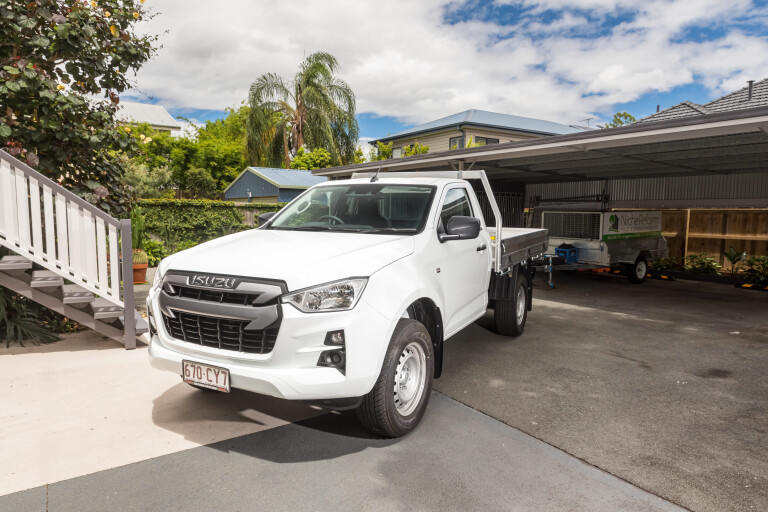
Isuzu's venerable 3.0-litre 4JJ3 turbo-diesel engine has been a driving force behind the success of the D-Max, and the MU-X too, proving its bulletproof reliability across nearly two decades of service.
While 4x4 D-Max models have flooded the roads, the quiet achiever workhorse (or darkhorse) 4x2 models have gained momentum – sitting second in the 4x2 segment to only the Toyota HiLux Workmate.
Since 2008 IUA has sold 42,018 4x2 D-MAX utes, accounting for nearly a quarter of all vehicle sales, but one thing has been missing – an entry-level small displacement engine option for fleet, trade and service markets. Until now.
From January 4 this year, Isuzu started offering the RZ4E-TC 1.9-litre turbo-diesel engine option for D-Max SX Single Cab Chassis models – a first for Australia but a proven powertrain across 4x2 and 4x4 D-Max models in Europe.
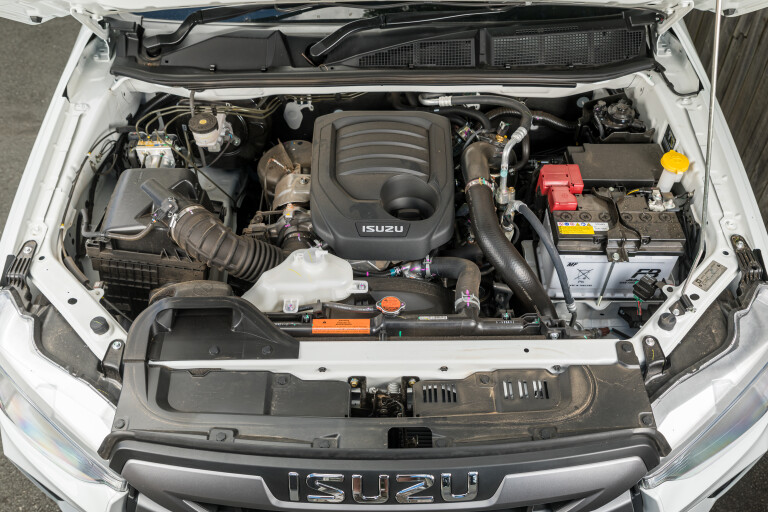
The frugal 1.9-litre oiler ticks all the boxes for the budget-spec 4x2 SX over the 3.0-litre; it’s cheaper, boasts more payload, offers improved economy and emissions, and it’s engineered to be just as durable as its brawnier sibling.
And for any of you wondering if the introduction of the RZ4E spells the beginning of the end for the 3.0-litre 4JJ3 in Australia? We don’t think so. Isuzu recently overhauled the old 4J jigger from the ground up, modernising it and bringing outputs up to par with modern buyer expectations.
With a compelling drive-away price of $29,990 for the manual, or $33,200 for an auto like the one we tested, is the 1.9-litre D-Max the entry-level 4x2 of choice?
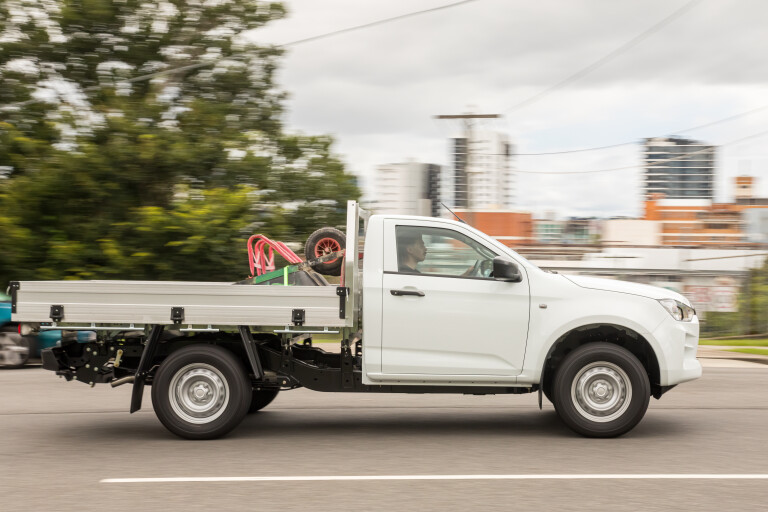
Design and interior
Visually, with the bonnet down at least, the 1.9-litre D-MAX 4x2 SX is indistinguishable from the thirstier 3.0-litre variant.
The same tensile steel ladder-frame chassis underpins the vehicle, with the same bang-up-to-date body on top and a massive factory-fitted aluminium tray at the back.
Isuzu ditched all low-rider models for ‘21, which means it’s a high-rider or nothing. We can’t think of many people, be they tradies, council workers, or weekend warriors, who’d prefer a low-rider model. The 4x2 D-Max looks so much like its 4x4 counterpart, while also boasting the ground clearance benefits, that only a keen eye would ever notice the missing diff and transfer case.
Inside the cab, it’s again no different to the latest-gen 3.0-litre SX models. Isuzu’s decision to offer the same level of tech and refinement in the base grade as you get in higher-spec 4x4 models is one we applaud.
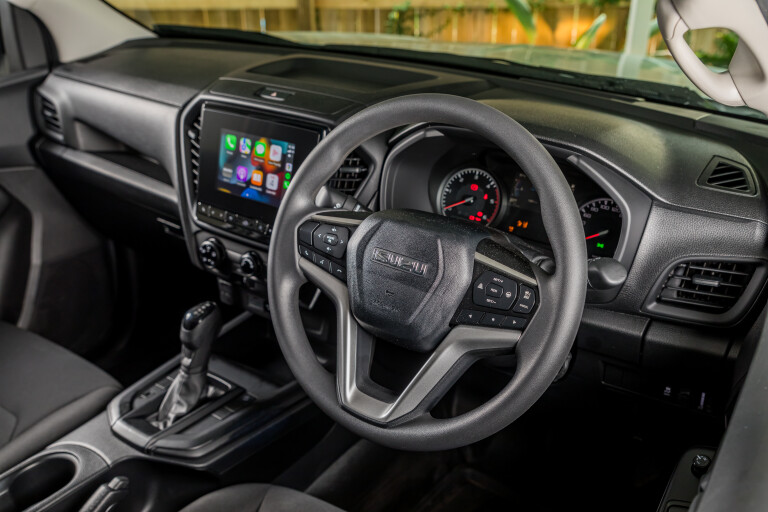
The standard inclusion of all safety and multimedia technology across the range makes an otherwise budget workhorse a pleasant place to spend your days. Always a plus when throwing down your hard-earned.
So what standard tech do you get, then? For starters, wireless (and wired) Apple CarPlay is seriously impressive for an entry-level work ute. Unfortunately, if you’re an Android user you’ll be forced to keep a cable handy.
Front and centre is a 7.0-inch display with simple, easy-to-use infotainment system that includes voice recognition, DAB+ radio, the smartphone mirroring tech and all the usual steering wheel controls.
Hard-wearing plastics and vinyl remain throughout the cabin, but fit and finish is solid with no rattles or questionable trim items in sight. This is an interior made to handle mud, dust or greasy post-smoko mitts with ease – just wipe it down and off you go.

The entire D-Max line-up scores a 5-star ANCAP safety rating, helped along by eight airbags; dual front, dual seat side, dual full-length curtain, front knee and centre.
As far as safety tech goes the D-Max gets it all, whether you’re opting for a base-spec SX or range-topping X-Terrain. Isuzu’s Intelligent Driver Assistance System (IDAS) features autonomous emergency braking with turn assist, adaptive cruise control, traffic sign recognition, blind-spot monitoring, rear cross-traffic alert, and lane-keep assist.
The addition of a ‘Lane Support System Switch’ on the steering wheel for 2022 D-Max models, allows drivers to turn off safety features on the go.
We didn’t switch any features off across the two weeks of testing, but given it’s quite a touchy system, particularly the lane-keep assist, it’s handy to know a two-second press of a switch is an option for those that find the autonomous safety systems a tad intrusive.

Powertrain
The 1.9-litre RZ4E-TC is by no means a new engine, serving overseas markets for the last five years or so, but it has been tweaked for harsh Australian conditions.
It produces 110kw of power at 3600rpm and a healthy 350Nm of twist from 1800-2600rpm. The spread of torque is meaty and the electronically-controlled variable geometry turbo spins up quickly, which distracts you from the pint-sized displacement.
A choice of Isuzu’s MVL-6Y manual transmission or Aisin-sourced six-speed automatic is offered behind the RZ4E, and both are great options depending on personal preference. You’ll pay more for the auto, though.
Direct injection fuelling is similar to that of the larger 4JJ3, utilising the same Denso HP5S fuel pump, as is the maintenance-free diesel particulate filter (DPF) mounted to the back of the turbo.

There are a couple of benefits of mounting the DPF, in Isuzu speak ‘DPD’, right behind the turbo; it’s not under the vehicle at risk of igniting grass, and it remains incredibly hot to ensure optimal efficiency.
Australians want longevity and robustness out of their diesels, which is why good ol’ cubes are still favoured here. Isuzu, however, says it has engineered the little RZ4E-TC to be durable enough to handle commercial duties.
The RZ4E-TC features an aluminium crankcase, cast-iron upper-block and aluminium alloy head, with a relatively low 15:9:1 compression ratio.
Internally, the RZ4E scores a nitrided carbon steel crankshaft, lightweight aluminium pistons featuring low-friction coating, and the bores are treated with Isuzu’s induction-hardened melt-in liners.
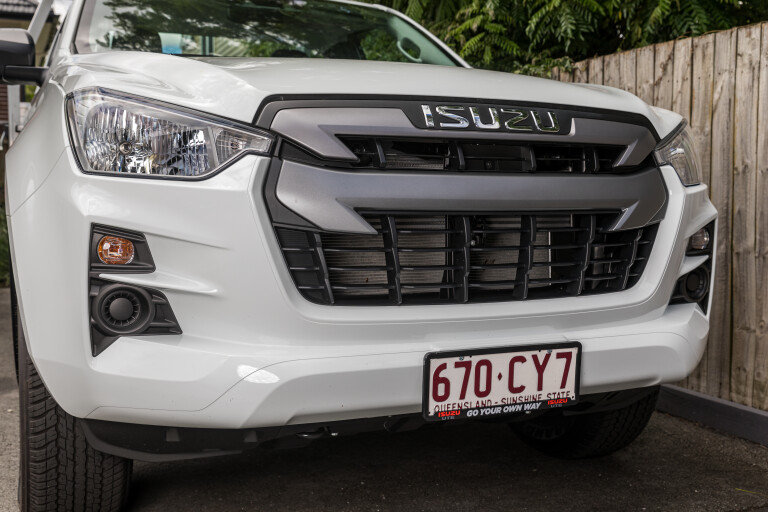
Double overhead camshafts have also had the lobes induction hardened, the valvetrain features automatic lash adjustment to ensure minimal maintenance, and a tough steel timing chain keeps it all in time.
Lastly, Isuzu says the use of an offset gudgeon pin helps to reduce engine noise – not that this is a particularly quiet diesel.
Isuzu claims an official fuel use figure of 7.0L/100km which, when paired with the 76-litre tank, gives drivers a healthy range between servo stops.
During two weeks of testing, we consistently sat between eight and nine litres to the hundred, with a final figure of 8.9L/100km. Day-to-day driving, with a mix of loaded and unloaded use, should see fuel use below 9.0L/100km, because you’ve got to drive the 1.9-litre D-Max pretty hard to see figures higher than that.
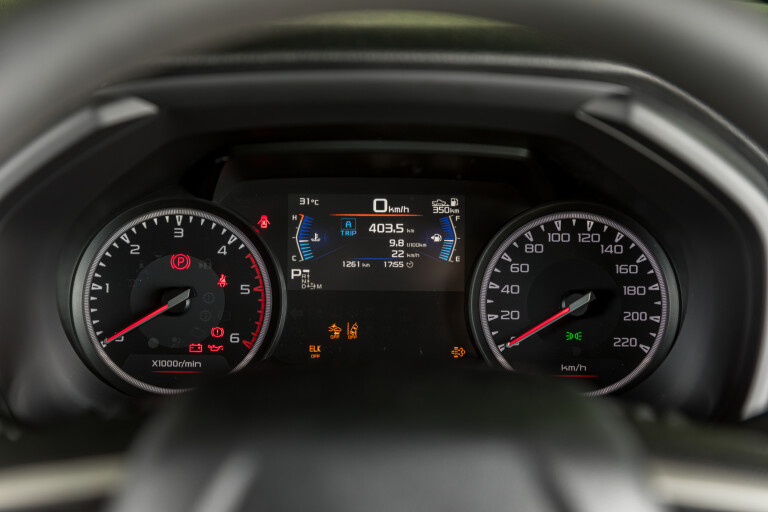
By the numbers
Sitting in the one-tonne ute segment, payload is critical and the D-Max now gets more of it – about 100kg, which is a decent increase.
Kerb weight is roughly 100 kegs down on the 3.0-litre variants, sitting at 1620kg for the automatic and 1595kg for the manual, while gross vehicle mass (GVM) remains at 3000kg.
Doing the maths, this gives the 1.9-litre SX models payloads of 1,405kg for the manual and 1,380kg for the automatic, which puts this D-Max among the best in the segment.
Speaking of payload, the factory-fitted 'Economy Alloy Tray' is massive, measuring up at 2550mm by 1777mm with drop-down sides and an impressive array of internal and external tie-down points.
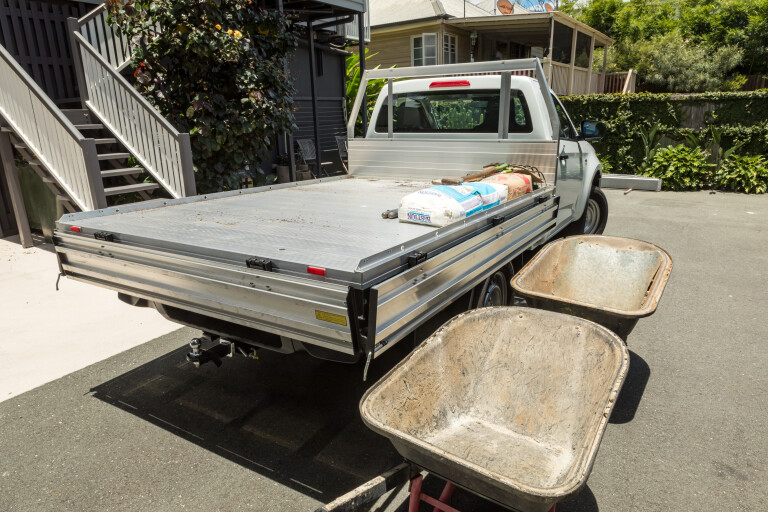
Isuzu also offers a range of genuine tray options, both alloy and steel, as well as various ladder racks, headboards, grab rails, lockable drawers and toolboxes.
Our test vehicle was fitted with the standard Economy Alloy Tray and tow pack with the option of a seven- or 12-pin plug, which we did use for a small box trailer.
Towing capacity is down slightly for the 1.9-litre SX due to a 550kg gross combination mass (GCM) reduction compared with the 3.0-litre, offering up braked towing capacities of 2800kg for the manual and 3000kg for the self-shifter. Unbraked towing capacity remains at 750kg.
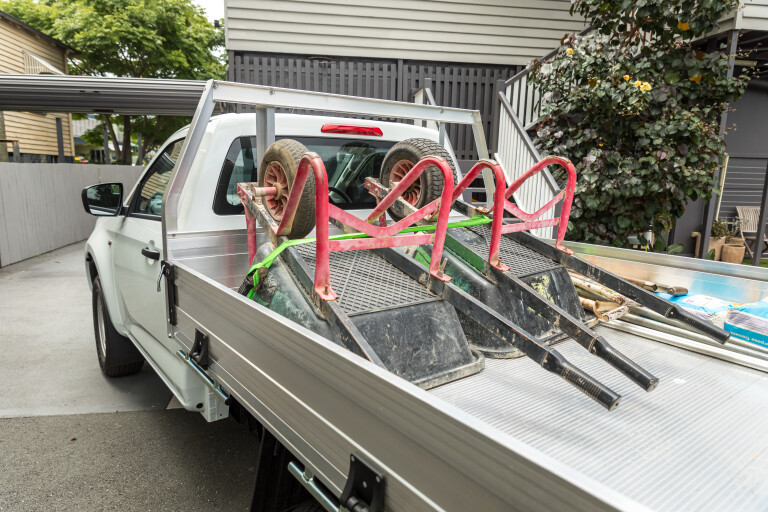
We only had about 400kg total in the tray at any one time, which to be expected made the ride a lot more compliant as the leaf springs settled a bit. We’d happily run around with a tonne on the back, because the rear-end is definitely set up to be loaded and is expectedly jolty when empty.
Ground clearance remains at 235mm, a real perk of high-rider 4x2 utes and great for venturing off the blacktop to access job sites.
Visually, buyers are given the colour choice of Mineral White, Basalt Black mica, Cobalt Blue mica, Mercury Silver metallic, or Obsidian Grey metallic.

What's it like to drive?
To answer the question simply, it drives bloody great. If you didn’t tell me, and I was driving sedately around town, I’d think it was the 3.0-litre. And I've spent a good 20,000km in D-Maxes over the years, so it really surprised me.
The smaller displacement is noticeable once you try to motivate some haste out of the D-Max, but for around-town use it’s not noticeably slower than the larger engine. In fact, because it’s more rev-happy, it gives the illusion of feeling peppier than it is.
You will notice it’s a little down on grunt when overtaking at highway speeds, but at anything less than triple figures it’s got enough pull to keep you out of trouble.
A big reason for this engine’s feeling of urgency is the impressive torque spread. Isuzu claims 85.7 per cent of the maximum torque output is available across 71.6 per cent of the torque band. So you’ve got at least 300Nm of the 350Nm maximum on tap from 1550rpm right through to 3700rpm.
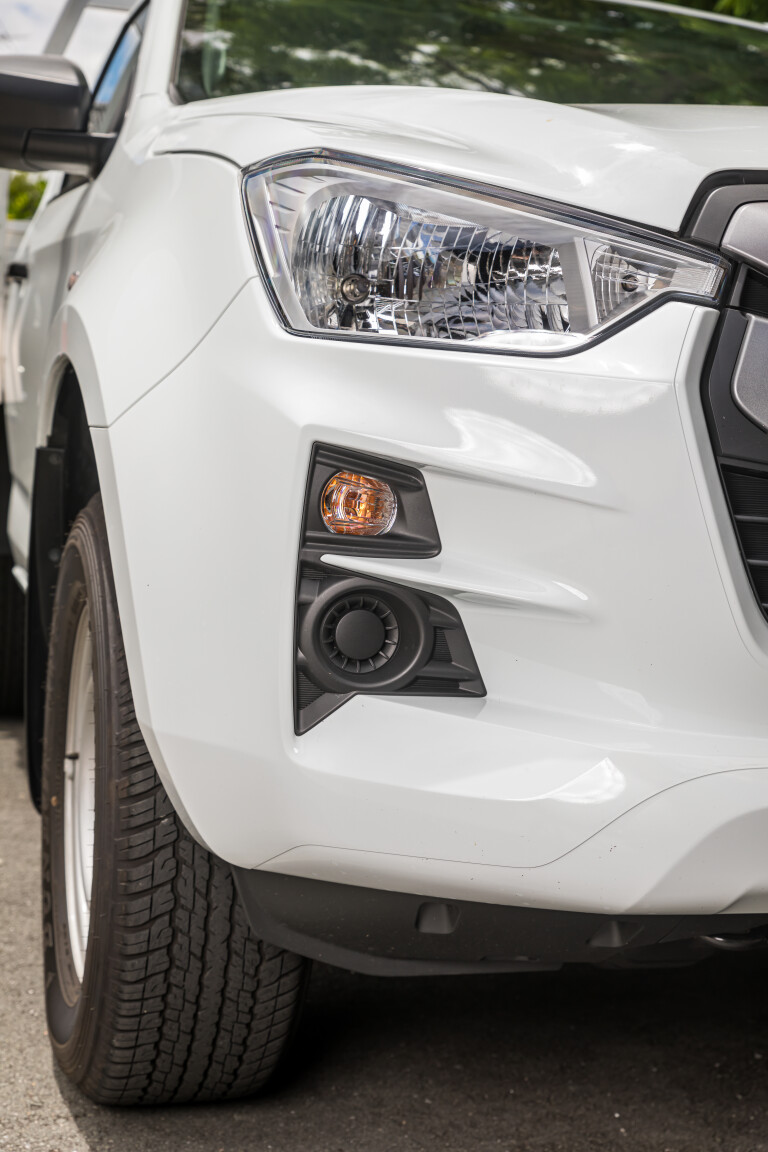
It’s easy to turn your nose up at anything below 450Nm these days, but, in a 4x2 work ute, that amount of torque is for the most part excessive. The one exception being towing. And on that, if you do plan on pulling a decent-sized trailer even semi-regularly, the 3.0-litre D-Max is the better pick.
The 1.9-litre retains the rattly diesel characteristics of its big brother, and is by no means an ultra-refined engine like other small-displacement ute options.
Surprisingly, the six-speed auto kept the little engine right in the meat of its torque band and didn’t feel undercogged at any point throughout testing. Again, Isuzu did a cracking job of giving this engine a strong mid-range that isn’t reliant on eight- or 10-speed gearbox sorcery to keep it singing.
Keeping tabs on fuel-use numbers, it becomes apparent this is a real camel of a diesel engine. No matter how hard we drove it, fuel use sat between eight and nine litres per 100km and I'm sure that number would dip even lower if you munched highway miles on the reg.
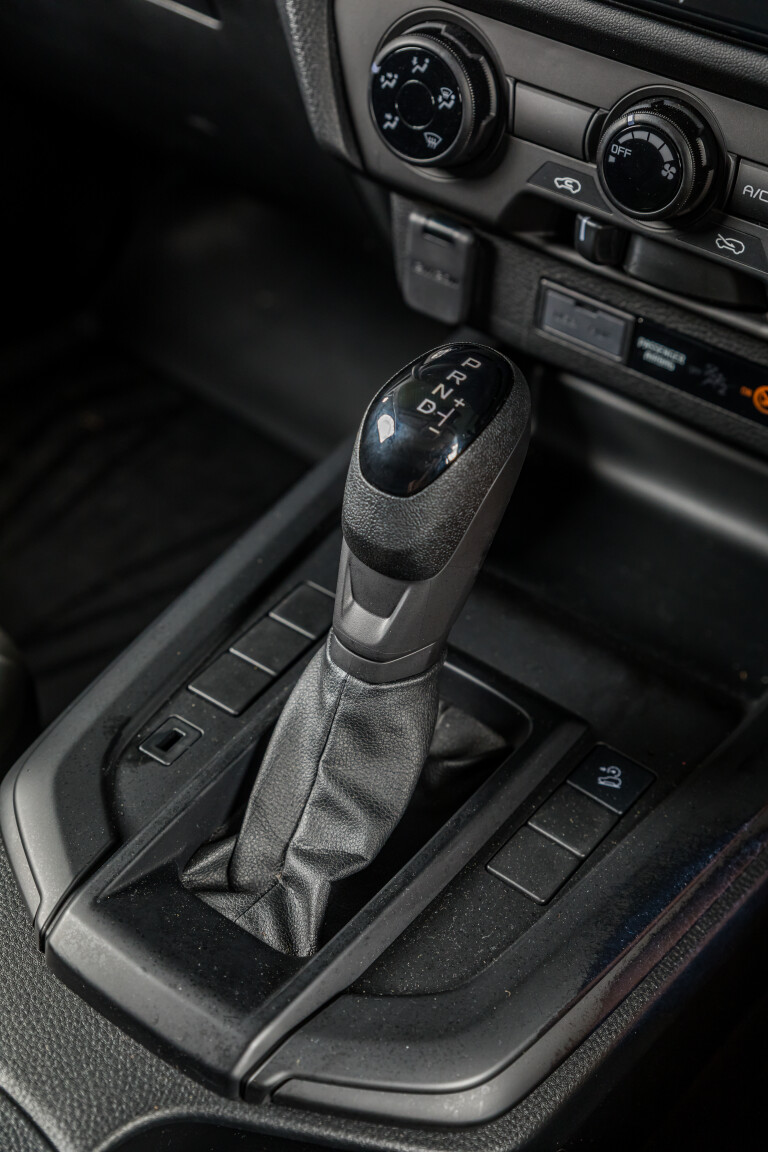
The 1.9-litre D-Max steers and stops exactly like the rest of the range, featuring the same electric power steering, suspension setup, brakes, 17-inch wheels with Dunlop AT25 tyres, and the driver controls are identical.
The coil suspension up front doesn’t feel quite as wallowy as the heavier 3.0-litre and body roll is lessened too. Hardly noticeable, but a perk of the lighter engine over the front axle nonetheless.
Ultimately, the only major difference here is less torque. Otherwise, it’s the same tried-and-tested D-Max workhorse. Unassuming occupants or drivers probably wouldn’t know the difference between this and the 3.0-litre model.
Inside, it’s well-appointed for a budget work ute with all the safety and multimedia tech any buyer is going to need. Wireless Apple CarPlay is a big winner for us, just because it’s not something you expect in a dedicated work vehicle.
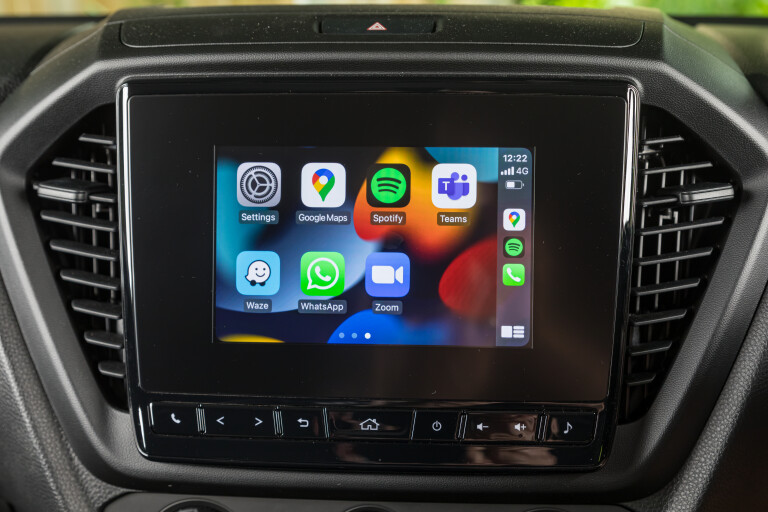
The safety tech, or IDAS as Isuzu calls it, is top-notch but can be quite intrusive. Realistically, it’s there to prevent crashes so it’s something you learn to put up with.
Lane-keep assist is particularly intrusive, occasionally wrestling you when changing lanes. I don’t recall the 3.0-litre SX being quite as overbearing, so it could be software tweaks to this new model. Either way, these systems will without a doubt prevent accidents.
All in all, the safety systems work incredibly well and the adaptive cruise control is a seriously useful standard inclusion at this price point.
The steering wheel-mounted ‘Lane Support System Switch’ is handy, too, allowing drivers to turn safety features off as they please. It’s good to have the option but we wouldn’t be turning any of it off in a vehicle like this.

Loaded up, the D-Max performed well and like every leaf-sprung ute, the rear settled and became a lot easier to live with around town. We had about 400kg in the tray, three days in a row, and in an ideal world you’d want some weight in there at all times to smooth out the ride.
Mind you, it’s still forgiving unladen. I live on a street with three speed bumps in either direction, and it didn’t buck me as much as other utes have.
There are loads of tie-down points and there is ample side visibility when loaded high against the headboard. The reverse camera is definitely worth using with these long alloy trays, because it’s always a bit of a guessing game without a peek at the camera when negotiating tight inner-city parking scenarios.
It’s a pretty hard ute to fault, given it’s essentially a cheaper, more fuel-efficient version of the already fantastic D-Max 4x2 SX.

Value and verdict
The as-tested price for the 2022 D-Max SX 1.9 is $33,200 plus on-road costs, which is $2,000 cheaper than the 3.0-litre version. Bear in mind, fuel savings will add further value for the 1.9-litre D-Max.
The manual SX 1.9 scores an introductory drive-away price of $29,990 – down from $31,200 plus on-road costs – and it’s the one we’d be going for. In a budget-spec work ute, a manual box will get the job done just fine and allow drivers to keep the 1.9 on the steam by holding gears.
If you plan on towing any more than 1000kg, get the 3.0-litre engine option because it lugs like a champ and will do a better job pulling the weight.
Otherwise, the 1.9-litre engine is our pick and given it’s a long-serving powertrain in overseas markets, it’s proven itself as a reliable option.

All D-Max models are covered by the same comprehensive ownership care package program, which includes a six-year/150,000km warranty, up to seven years roadside assistance, and seven years of capped-price servicing for private, ABN and fleet customers.
The 1.9-litre RZ4E-TC is Isuzu's most cost-effective engine option to maintain, too, with the seven years of capped-price servicing (based on 15,000km travelled per year) totalling $3,223 versus $3,513 for the 3.0-litre 4JJ3-TCX.
Opt for the manual ‘box and you’ve got a safe, capable, and robust work ute for under $30,000 – still not the cheapest in this segment but it’s loaded with safety tech, which is where the extra value lies.
2022 Isuzu D-Max 4x2 SX 1.9 specifications
| Body | Two-door ute |
|---|---|
| Drive | Rear-wheel |
| Engine | 1.9-litre inline four-cylinder turbo-diesel |
| Transmission | Six-speed automatic |
| Power | 110kW @ 3600rpm |
| Torque | 350Nm @ 1800-2600rpm |
| Weight | 1620kg |
| L/W/H | 5325/1870/1790mm |
| Wheelbase | 3125mm |
| Ground clearance | 235mm |
| Tracks | 1570mm |
| Turning circle | 12.5 metres |
| Tray length | 2550mm |
| Payload | 1380kg |
| Towing capacity (braked) | 3000kg |
| Fuel tank capacity | 76L |
| Fuel Economy (claimed) | 7L/100km |
| Fuel Economy (as tested) | 8.9L/100km |
| Suspension | Independent coil springs (f); Semi-elliptic leaf springs (r) |
| Steering | Electronic power steering |
| Brakes | 320mm ventilated discs (f); Drum brakes (r) |
| Wheels | 17 steel all-round |
| Tyres | 255/65 R17 Dunlop AT25 All-terrain tyres |
| Price | $33,200 (plus on-road costs) |
Score breakdown
Things we like
- Increased payload over 3.0-litre variant
- Wireless CarPlay (in a work ute, no less!)
- Impressive fuel economy, even when driven with urgency
- Strong torque delivery, despite pint-sized displacement
Not so much
- Slightly overbearing lane-keep assist
- Braked towing capacity down on 3.0L

COMMENTS